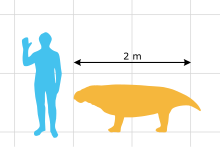Ufudocyclops
Ufudocyclops is an extinct genus of stahleckeriid dicynodont from the Middle Triassic of South Africa. It was found in the Burgersdorp Formation, part of the uppermost Cynognathus Assemblage Zone of the Beaufort Group in the Karoo Basin. The type and only known species is U. mukanelai. It was a large, beaked herbivore like other Triassic dicynodonts, lacking tusks, and is mostly characterised by unique features of the skull. It is known from three specimens, two of which were previously referred to the Tanzanian dicynodont Angonisaurus. The separation of Ufudocyclops from Angonisaurus indicates that the Middle Triassic fauna of the Beaufort Group in South Africa was not part of a larger shared fauna with those of the Manda Beds in Tanzania, as was previously supposed, and suggests that they were separated as more localised faunas, possibly by geographic barriers or in time. Ufudocyclops then would have been a unique part of the uppermost Cynognathus Assemblage Zone in South Africa. It is also the oldest known member of the family Stahleckeriidae, and implies that the family was already diversifying in the Middle Triassic alongside other kannemeyeriiforms, not just in the Late Triassic after other families died out.
Ufudocyclops is a large dicynodont, with the largest specimen reconstructed to have an estimated skull length of 35 centimetres (14 in) and the smaller complete holotype skull at approximately 29 centimetres (11 in) long, and an estimated overall body size similar to that of Kannemeyeria. Only skulls and one partial lower jaw are definitively known, and no postcrania from the body has been identified, but it likely resembled other stahleckeriid dicynodonts with a heavily built body, short tail, and stocky limbs, possibly including upright hind-limbs paired with sprawling forelimbs like other large dicynodonts. Like some other stahleckeriids, Ufudocyclops appears to have lacked the tusks characteristic of many other dicynodonts, and was completely toothless.[1][2]
The skull of Ufudocyclops superficially resembles Angonisaurus, being relatively tall and notably broad behind the snout, with large, sideways facing eyes and prominent tuskless caniniform processes on the maxilla that project away down and forwards from the snout, flaring out slightly to sides, with blunted tips. The lower surfaces of the maxilla are heavily pitted and rugose, as is the premaxilla and the palate on the roof of the mouth. These textures correspond to the eponymous tortoise-like keratinous beak typical of dicynodonts like Ufudocyclops. The isolated tip of the premaxilla demonstrates that these pits are superficial and do not continue deeper into the bone, as the inner texture of the bone is smooth and tabulate, and so are not foramina.[1]
Like various other dicynodonts, the face is ornamented with bony bosses on the snout around the eyes. The bulbous nasal bones on the top of the snout each sport a single ovoid-shaped boss that overhangs the nostrils and stops just short of the orbits (eye sockets) in front of the eyes. The paired bosses are separated by a 3–7 cm (1–3 in) wide gap of flat, featureless bone between them on top of the snout where the premaxilla and the nasals meet. This is an unusual condition for kannemeyeriiforms, which typically only have a single large boss across the whole surface of the snout. In fact, the bosses are superficially more like those of cryptodonts—a group of Permian dicynodonts unrelated to kannemeyeriiforms—that also had a pair of divided nasal bosses. Similar, but smaller, bosses are found on the prefrontal and postorbital bones, situated around the upper front and back corners of the eyes, respectively. Like the nasal bosses, these two bosses are clearly separated as individual growths, and do not form a continuous rim around the top of the eyes.[1]

